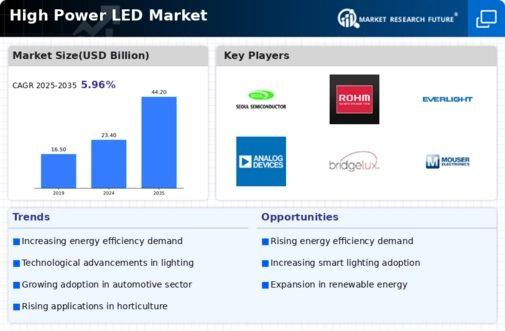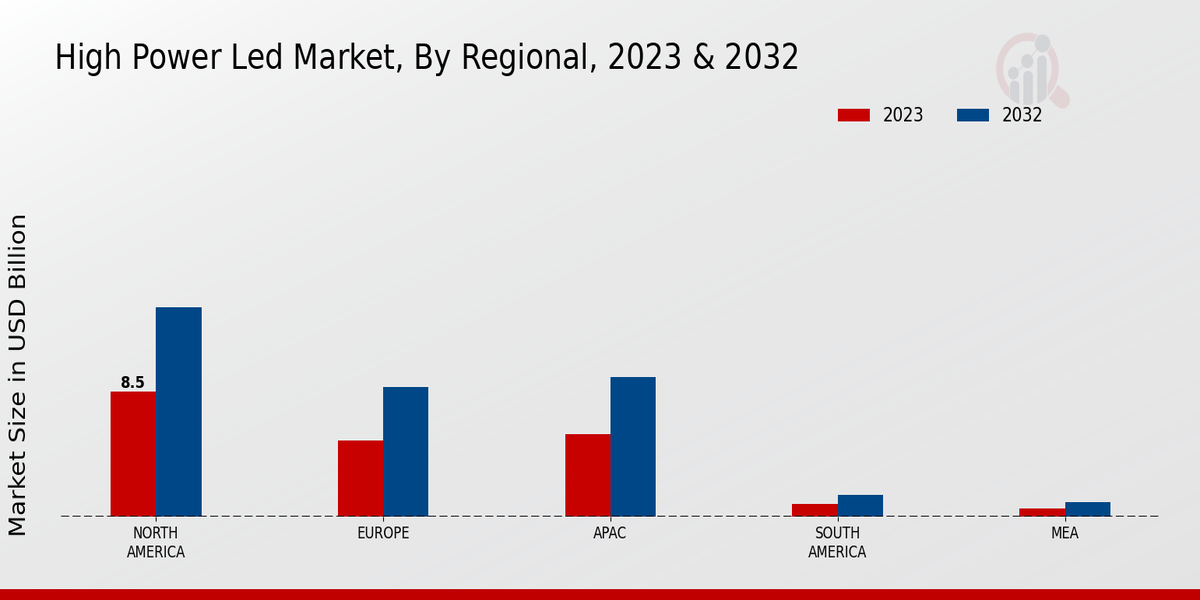Market Growth Projections
The Global High Power LED Market Industry is poised for substantial growth, with projections indicating a market value of 23.4 USD Billion in 2024 and an anticipated increase to 44.2 USD Billion by 2035. This growth trajectory reflects a compound annual growth rate of 5.96% from 2025 to 2035. The expansion is driven by various factors, including technological advancements, rising energy costs, and increasing consumer demand for sustainable lighting solutions. As the industry evolves, it is likely to witness innovations that further enhance the performance and applications of high power LEDs, solidifying their position in the global market.
Growing Demand for Energy Efficiency
The Global High Power LED Market Industry experiences a robust demand for energy-efficient lighting solutions. As energy costs continue to rise, consumers and businesses alike seek alternatives that reduce electricity consumption. High power LEDs offer a longer lifespan and lower energy usage compared to traditional lighting options. This trend is particularly evident in commercial sectors, where energy savings can significantly impact operational costs. The industry's projected value of 23.4 USD Billion in 2024 underscores the increasing adoption of these technologies. Furthermore, as sustainability becomes a priority, the shift towards high power LEDs is expected to accelerate, contributing to a compound annual growth rate of 5.96% from 2025 to 2035.
Government Initiatives and Regulations
Government policies and regulations significantly influence the Global High Power LED Market Industry. Many countries implement standards aimed at reducing energy consumption and promoting sustainable practices. Incentives such as tax rebates and subsidies for energy-efficient technologies further encourage the adoption of high power LEDs. For example, various governments have set ambitious targets for reducing greenhouse gas emissions, which often include transitioning to energy-efficient lighting solutions. These initiatives not only foster market growth but also align with global sustainability goals. As a result, the industry is likely to see increased investments and innovations driven by regulatory frameworks.
Technological Advancements in LED Technology
Technological innovations play a pivotal role in the Global High Power LED Market Industry. Continuous research and development efforts have led to enhancements in LED efficiency, brightness, and color rendering. For instance, advancements in chip technology and thermal management have resulted in higher lumen output and better performance in various applications. These improvements not only cater to consumer preferences but also expand the potential applications of high power LEDs in sectors such as automotive and horticulture. As the market evolves, these technological strides are likely to drive growth, with projections indicating a market value of 44.2 USD Billion by 2035.
Rising Urbanization and Infrastructure Development
Urbanization trends are a key driver of the Global High Power LED Market Industry. As populations migrate towards urban centers, the demand for efficient lighting solutions in infrastructure projects escalates. High power LEDs are increasingly utilized in street lighting, public spaces, and commercial buildings due to their energy-saving capabilities and longevity. This trend is particularly pronounced in developing regions, where rapid urban growth necessitates sustainable infrastructure solutions. The integration of high power LEDs in smart city initiatives further enhances their appeal, as cities aim to improve energy efficiency and reduce operational costs. This growing urbanization is expected to contribute significantly to the market's expansion.
Consumer Awareness and Preference for Sustainable Products
Consumer awareness regarding environmental issues is reshaping the Global High Power LED Market Industry. As individuals become more conscious of their ecological footprint, there is a marked preference for sustainable products, including high power LEDs. These lighting solutions are perceived as eco-friendly alternatives due to their reduced energy consumption and lower carbon emissions. This shift in consumer behavior is evident in various sectors, including residential, commercial, and industrial applications. Companies are responding by promoting the benefits of high power LEDs, thereby enhancing market penetration. This growing consumer preference is anticipated to drive market growth, aligning with the industry's projected trajectory.















